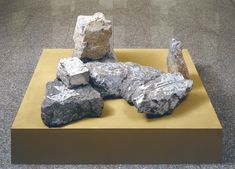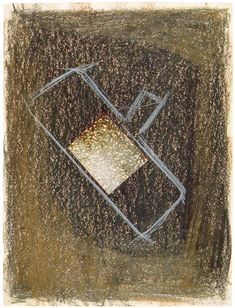Lois Weinberger
Lois Weinberger was born in 1947 in Stams, Tyrol, Austria. He first completed an apprenticeship as a locksmith and art artsmith (1963-1977) and then attended the Vienna School of Art. From 1993 to 1994 he taught at the State Academy of Fine Arts, Karlsruhe, Germany, and received a Artists' Residency at Künstlerhaus Bethanien, Berlin, Germany, from 1994-95, as well as the Great Art Scholarship of the Province of Tyrol in 1999. From 1996 to 2004 he participated in several symposia and gave lectures and guest lectures on art and nature as well as natural landscapes at renowned institutions, colleges and universities in Austria, Germany, Italy, France and Japan.
The artist has participated nationally and internationally in numerous major and group exhibitions, including 1985 De Sculptura, Vienna, 1991 Biennale São Paulo, Brazil, 1997 documenta X Kassel, Germany, 2001 Sonsbeek 9, Arnhem, Belgium, 2004 Liverpool Biennale, UK, 2009 the artist represented Austria in the Austrian Pavilion, Biennale di Venezia, Italy and 2017 documenta 14, Athens, Greece and Kassel, Germany. Solo exhibitions dedicated to the artist included 1999 Watari-Um Museum of Contemporary Art Tokyo, Japan, 2000 Camden Arts Centre, London, UK, 2000 Museum Moderner Kunst 20er Haus Vienna, 2001 Bonner Kunstverein, Germany, 2002 Galerie im Taxispalais, Innsbruck, Austria, 2003 Villa Merkel Esslingen and Kunstverein Hannover, Germany, 2004 Kunsthallen Brandts Klaedefabrik, Odense, Oslo, Norway, 2005 S.M.A.K. Stedelijk Museum voor Actuele Kunst, Gent, Belgium, 2008 Lentos Kunstmuseum Linz, Austria, 2009 tranzit, Bratislava, Slovakia, 2011 Musée d'Art Moderne, Saint Etienne, France, 2012 Villa Dieu Seul Sait, Cotonou, Benin, 2013 Landesmuseum Ferdinandeum, Innsbruck, Austria, 2015 S.M.A.K. Stedelijk Museum voor Actuele Kunst, Ghent, Belgium, 2015 Kunsthalle Mainz, Germany, 2016 Salle Principale, Paris, France, 2017 nGbK, Berlin, Germany, 2018 Frac Franche-Comté, Besancon, France, 2019 Watari-Um Museum of Contemporary Art, Tokyo, Japan, 2019 Tinguely Museum, Basel, Switzerland and posthumously in 2021 the 21er Haus Belvedere, Vienna.
The artist has received numerous awards, including the Förderungspreis für Bildende Kunst, Federal Ministry for Education and the Arts, Vienna, in 1985; the City of Vienna Prize for Fine Arts, 1998; the Würdigungspreis für Bildende Kunst, Federal Chancellery, Vienna, and the Medal of Honor of the Leopold Franzens University, Innsbruck, in 2005; and the Tyrolean Regional Prize for Art, 2006. In 2007, the University of Innsbruck honored Weinberger on his 60th birthday by appointing him professor. In 2010, he received the Würdigungspreis für Bildende Kunst of the Province of Lower Austria and in 2014, the Art Prize of the Klocker Foundation Innsbruck, Tyrol.
Lois Weinberger lived and worked in Innsbruck, Gars am Kamp and in Vienna, where he died in 2020.
Lois Weinberger's interest was in nature, which had been displaced by human civilization. Since the 1970s, he became an uncomfortable thought leader and pioneer for ecological awareness, and his work triggered discussions about the relationship between nature and culture. The range of his artistic means was broad: the traditional media of drawing, printmaking, painting, and sculpture increasingly receded into the background. Over the years he found his way to a conceptual way of working and a process-oriented way of thinking, for which film, action and the use of found objects were more suitable. He has been working with his wife Franziska since 1999.
Lois Weinberger, who unpretentiously described himself as a "field worker," was a subversive activist and practiced ecological resistance. He was concerned with creating free spaces for nature. He found these in marginal areas and at the intersections of civilization and nature, where he sowed inferiorly classified plants or allowed spontaneous vegetation. For him, the wildly growing weeds were a symbol of the marginalized, the undesirable, and the disorderly. In his works, he addressed unbridled growth beyond all cultivation, as a symbol of becoming and passing away and as a political metaphor for the Other.
Weinberger called his plantings " areas " to distinguish them from the conscious design of the gardens he laid out. He preferred plants from the Pannonian region, the Hungarian lowlands, the Welser Heide and the urban environment. These were always so-called ruderal plants, which settle unnoticed on coarse soils, in uncultivated marginal areas and intermediate zones, and adapt their survival to the most difficult conditions.
After the fall of the Berlin Wall in 1989, Weinberger watered the scrub in the death strip. In 1993, he carried out the action "Burning and Walking" in the city of Salzburg during the festival season, had an eight-by-eight-meter field hewn out of the asphalt in the city center, and left this gap in the ground to the wind and chance for planting. For his participation in documenta X (1997), he scattered seeds of foreign, non-native plants from southern and southeastern Europe on a disused railroad track at Kassel's Kulturbahnhof. The planting spread as invasive wild growth, displacing, overgrowing, and intermingling with native vegetation, sparking debates about hierarchies, cultures, and migration as political metaphor, and attracting international attention. This work remained permanently in Kassel. As part of documenta XII (2017), Weinberger presented his family history in combination with the "weeds" that grew on his parents' farm in a showcase in Athens. In Kassel, the artist couple disturbed the English lawn in the Karlsauen with an area of weeds.
The realization of similar projects took Weinberger to Dresden, Florence, Marseille, Sao Paolo and as far as Tokyo, where he planted the roof of the Museum of Contemporary Art. Small projects for windowsills were created and planted plastic bags became portable gardens. The largest area was created in eleven years of work on an area of about 500m2 on the Old Danube in Vienna.
The Generali Foundation collection includes two of the artist's early works, a paper work and a group of seven roughly hewn lime stones of varying sizes titled "the sleep". These are not sculptures in the traditional sense, which would have been created from a larger stone in a material-removal process of finding form. The artist left the lime stones largely unworked, accepting them as they are. The lack of a fixed arrangement corresponds to Weinberger's rejection of rigid principles of order. He took the raw chunks from unaltered nature into the artificial museum space where, as unaltered stones, they represent the relationship between nature and man as a simple statement: Indifference. (DL)

